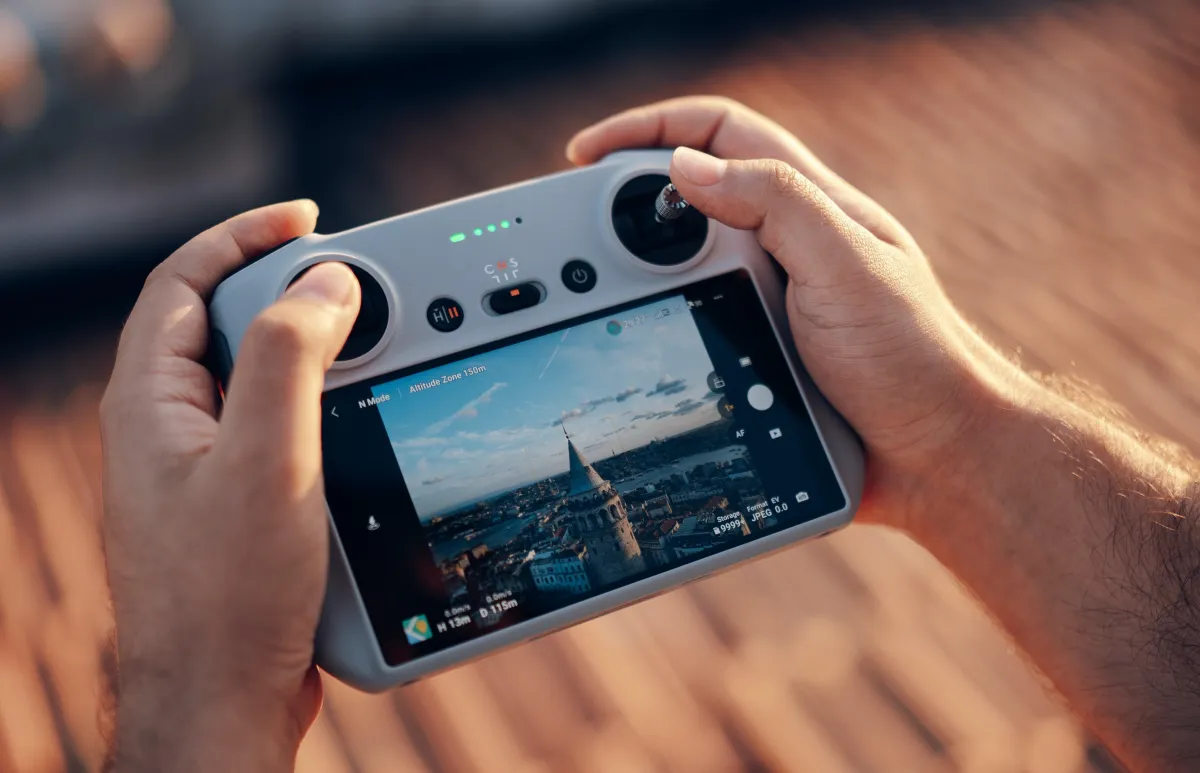
How Does a Drone Controller Work?
Drones, with their ability to soar the skies and capture breathtaking views, have captured the imagination of millions. The allure isn't just in the panoramic views they offer but also in the intricate technology that powers them. As they glide effortlessly, have you ever stopped to ponder the intricate systems that make it all possible? A significant part of that magic resides in the drone controller. This device acts as the brain and hands of the pilot, translating human inputs into drone actions. How Does a Drone Controller Work? Let's delve deeper.
The Basics of Drone Operation
The art of drone operation can be likened to the dance between a conductor and an orchestra. Every motion, every hover, and every aerial maneuver is dictated by commands sent from the remote controller also known as the flight controller. The technology onboard the drone then interprets these commands and translates them into physical actions, making the drone a marvel of modern engineering.
The Role of a Drone Controller
Consider yourself in a car without a steering wheel. Impossible to navigate, right? Similarly, a drone without a controller is directionless. The controller acts as a bridge between the pilot and the drone, ensuring that every command is executed precisely, making aerial navigation seem effortless.
Can a drone fly without a flight controller?
Yes, certain toy and beginner-level drones can operate independently without a traditional remote controller. Instead, users have the option to control them via smartphones or even through hand gestures.
How Does a Drone Controller Work: Components of a Drone Controller
If the drone takes center stage like a star performer, then the controller acts as the backstage director, orchestrating every detail to ensure a seamless and impeccable show. From drone controller buttons to the intricate drone control system, each component plays a pivotal role in ensuring a smooth flight experience.
Transmitter and Receiver
At its most fundamental level, the drone's operation relies on a conversation between the transmitter in the controller and the receiver onboard the drone. When a pilot manipulates the joysticks, the transmitter sends out radio signals encoded with the desired action. The receiver then decodes these signals and instructs the drone's motors accordingly, making flight possible.
Joysticks and Buttons
Joysticks and buttons are the pilot's interface with the drone. Each joystick typically controls a specific aspect of the drone's movement:
Left Joystick: Controls throttle (altitude) and yaw (rotation).
Right Joystick: Manages pitch (forward and backward movement) and roll (sideways movement).
Buttons, on the other hand, provide quick access to essential functions, enhancing the pilot's control over the drone.
Power Button: The primary switch to turn the controller on or off.
Return-to-Home Button: Commands the drone to return to its take-off point.
Camera Controls: Buttons to capture photos or start/stop video recording.
Emergency Stop Button: Immediately halts all drone movements and stabilizes it in case of emergencies.
Speed Switch: The speed switch allows pilots to adjust the drone's flight speed. Depending on the model, drones may offer multiple speed settings, from slow and steady for beginners to faster speeds for experienced pilots.
Gimbal Tilt Wheel: The gimbal tilt wheel provides control over the drone's camera angle. By adjusting the wheel, pilots can tilt the camera up or down, capturing different perspectives during flight.
LCD Display
Flying a drone requires a keen awareness of its operational status. The FPV drone controller screen provides vital real-time data:
Battery Levels: Displays the remaining battery life of both the controller and the drone.
Signal Strength: Indicates the quality of the connection between the controller and the drone.
GPS Data: Shows the drone's location, altitude, and speed.
Camera Feed: Live video feed from the drone's camera, allowing pilots to see the drone's perspective.
Flight Modes: Indicates the current flight mode (e.g., GPS mode, manual mode).
Altitude: The drone's current height above ground level.
Speed: The drone's current speed, often displayed in meters per second or another relevant unit.
This data ensures that pilots can make informed decisions, ensuring safe and efficient flights.
Batteries
Controllers typically come with built-in batteries that are rechargeable. These batteries power the device and often have varying capacities depending on the controller's model and features. It's crucial to monitor battery levels to ensure uninterrupted operation.
Antennas
Controllers have antennas that facilitate communication between the controller and the drone. These antennas help in maintaining a stable connection, especially over longer distances, by transmitting and receiving radio signals.
What is RFID and why is it important?
RFID, or Radio-Frequency Identification, employs electromagnetic fields to recognize and trace tags affixed to items. In the context of drones, RFID can be used for various purposes, such as tracking drone components, ensuring secure communication, or implementing geofencing to restrict drone flight in certain areas. Its importance lies in its ability to provide accurate and real-time information, enhancing safety and control.
What is a fully autonomous drone?
Fully autonomous drone operates without direct human intervention. It uses advanced sensors, GPS, and pre-programmed algorithms to navigate, avoid obstacles, and perform tasks. This drone can be programmed to follow specific flight paths, conduct inspections, or even deliver payloads without human control, revolutionizing industries like agriculture, construction, and logistics.
How far can a drone fly from its controller?
The maximum distance a drone can fly from its controller, known as the signal range or transmission range, varies depending on several factors:
Drone Model: High-end drones typically have longer ranges compared to toy or beginner models.
Environment: Obstacles, interference, and atmospheric conditions can impact signal strength.
Regulations: Some countries have regulations specifying the maximum allowable range for drone operations. Generally, commercial drones can fly up to several kilometers from their controllers under optimal conditions, but it's essential to maintain a clear line of sight and adhere to local regulations.
How Does a Drone Controller Work: How Signals are Transmitted
Radio frequencies are the backbone of drone communication. It's similar to tuning into your favorite radio station but with much higher stakes!
Radio Frequencies and Channels
Much like how radio stations broadcast on specific frequencies, drones operate within designated frequency bands. These bands are divided into channels, allowing multiple drones to operate simultaneously without interference. Understanding these frequencies and channels is crucial for ensuring smooth and uninterrupted flight operations.
Real-time Feedback
Modern drone controllers are equipped with advanced telemetry systems that provide pilots with real-time feedback on the drone's performance. This feedback, displayed on the controller's screen, offers insights into battery health, GPS signal strength, wind speed, and more, empowering pilots to make data-driven decisions.
Safety Measures
Safety is paramount in the world of drones, given their potential to interact with both people and property.
Signal Range and Interference
The signal range, also known as the transmission range, defines the maximum distance between the controller and the drone. Factors like obstacles, electromagnetic interference, and atmospheric conditions can impact this range. By understanding these variables, pilots can mitigate risks and ensure safe flights.
Battery Management
A drone's flight duration is limited by its battery life. Effective battery management, including monitoring voltage levels and implementing smart flight strategies, ensures that the drone returns safely to its pilot.
Best Practices and Tips
Mastering the art of drone flying requires practice, patience, and continuous learning.
Calibration and Setup
Regular calibration of the controller and the drone's onboard systems is essential for maintaining optimal performance. It ensures that the drone responds accurately to pilot commands, minimizing the risk of unexpected behavior during flight.
Updating Your Controller's Software
Updating the software of your drone controller is a simple yet effective way to ensure optimal performance, safety, and access to the latest features. By staying informed and regularly checking for updates, you can maximize your flying experience and enjoy the full capabilities of your drone and controller.
Upgrading Your Controller
As drone technology evolves, so do controllers. Upgrading to the latest models can enhance the flying experience, offering advanced features, improved ergonomics, and enhanced reliability.
How to calibrate the drone controller?
Power on the controller.
Access the controller's settings and calibration menu.
Follow the on-screen instructions, which typically involve moving joysticks in specific patterns or sequences.
Conclusion
Drones have revolutionized our perspective of the world from above. Behind every great drone's mesmerizing flight and breathtaking aerial views is a trusty controller and a skilled pilot, turning dreams of flight into reality.
How Does a Drone Controller Work: FAQs
Can any controller work with any drone?
While some controllers are compatible with multiple drones, it's essential to check compatibility to ensure seamless operation.
How does the controller send the signal to the drone?
The controller sends signals to the drone via radio frequencies, which are received and interpreted by the drone's onboard receiver.
Do drone controllers require batteries?
Yes, most controllers use replaceable or rechargeable batteries.
Can interference affect my drone's performance?
Absolutely. Interference can disrupt communication between the controller and the drone, potentially leading to control loss.
Is it easy to control a drone?
While modern drones are equipped with user-friendly controls, mastering precise maneuvers and ensuring safe flights requires practice and skill.
Explore further in articles from MDPI and Springer publications.

Copyright © Drone Guide Central - All Rights Reserved 2024

